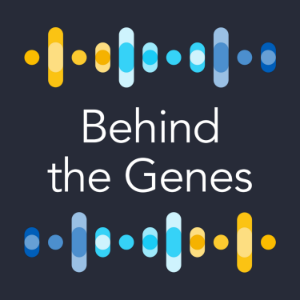
Behind the Genes
Science Podcasts
We are Genomics England and our vision is to create a world where everyone benefits from genomic healthcare. Introducing our refreshed podcast identity: Behind the Genes, previously known as The G Word. Join us every fortnight, where we cover everything from the latest in cutting-edge research to real-life stories from those affected by rare conditions and cancer. With thoughtful conversations, we take you behind the science. You can also tune in to our Genomics 101 explainer series which breaks down complex terms in under 10 minutes.
Location:
United Kingdom
Genres:
Science Podcasts
Description:
We are Genomics England and our vision is to create a world where everyone benefits from genomic healthcare. Introducing our refreshed podcast identity: Behind the Genes, previously known as The G Word. Join us every fortnight, where we cover everything from the latest in cutting-edge research to real-life stories from those affected by rare conditions and cancer. With thoughtful conversations, we take you behind the science. You can also tune in to our Genomics 101 explainer series which breaks down complex terms in under 10 minutes.
Language:
English
Amanda Pichini: What is a genetic counsellor?
Duration:00:08:02
Dr Emily Perry: What is the Genomics England Research Environment?
Duration:00:05:13
Jenna Cusworth-Bulger, Tracie Miles and Rachel Peck: How are families and hospitals bringing the Generation Study to life?
Duration:00:40:32
Dr Nour Elkhateeb: What is a clinical geneticist?
Duration:00:09:31
Francisco Azuaje, Karim Beguir, Harry Farmer and Dr Rich Scott: How can cross-sector collaborations drive responsible use of AI for genomic innovation?
Duration:00:38:08
Dr Harriet Etheredge, Gordon Bedford, Suzalee Blair-Gordon and Suzannah Kinsella: How do people feel about using genomic data to guide health across a lifetime?
Duration:00:30:35
Dr Natalie Banner, Paul Arvidson, Dr Rich Gorman and Professor Bobbie Farsides: How can we enable ethical and inclusive research to thrive?
Duration:00:42:02
Vivienne Parry, Alice Tuff-Lacey, Dalia Kasperaviciute and Kerry Leeson Bevers: What can we learn from the Generation Study?
Duration:00:34:03
Dr Ana Lisa Tavares, Anne Lennox, Dr Meriel McEntagart, Dr Carlo Rinaldi: Can patient collaboration shape the future of therapies for rare conditions?
Duration:00:46:08
Dr Gavin Arno, Kate Arkell, Bhavini Makwana and Naimah Callachand: Can genomic research close the diagnostic gap in inherited sight loss?
Duration:00:29:47
Dr Natalie Banner, Dr Raghib Ali, Professor Naomi Allen, Dr Andrea Ramírez: How can we unlock the potential of large-scale health datasets?
Duration:00:37:53
John Pullinger: What is the diagnostic odyssey?
Duration:00:04:59
Jillian Hastings-Ward, Dr Karen Low and Lindsay Randall: How can parental insights transform care for rare genetic conditions?
Duration:00:29:26
Dr Rich Scott and Adam Clatworthy: Reflecting on 2024 - A year of change and discovery
Duration:00:48:52
Katrina Stone: What happens when I go for whole genome sequencing?
Duration:00:04:46
Mel Dixon, Jo Balfour and Dr Rona Smith: How can we work with patients to drive research initiatives?
Duration:00:39:21
Meriel McEntagart: Are genetic conditions always inherited from parents?
Duration:00:06:13
Meriel McEntagart: Are genetic conditions always inherited from parents?
Duration:00:05:02
Helen White, Professor Ian Tomlinson, Claire Coughlan and Dr David Church: Can genetic discoveries revolutionise bowel cancer care?
Duration:00:34:21
Adrianto Wirawan: What does 'no primary findings' mean?
Duration:00:03:57